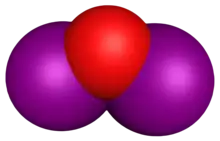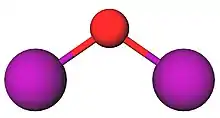Diiodine oxide
Diiodine oxide, also known as iodohypoiodite, is an oxide of iodine that is equivalent to an acid anhydride of hypoiodous acid. This substance is unstable and it is very difficult to isolate.[2]
 | |
 | |
| Names | |
|---|---|
| IUPAC name
Diiodine oxide | |
| Systematic IUPAC name
Iodohypoiodite[1] | |
| Other names
Iodine hypoiodide, diiodooxidane, diiodine monoxide, hypoiodous anhydride | |
| Identifiers | |
3D model (JSmol) |
|
PubChem CID |
|
| |
| |
| Properties | |
| I2O | |
| Molar mass | 269.808 g/mol |
| Related compounds | |
Related compounds |
|
Except where otherwise noted, data are given for materials in their standard state (at 25 °C [77 °F], 100 kPa).
Infobox references | |
Preparation
Diiodine oxide can be prepared by reacting iodine with potassium iodate (KIO3) in 96% sulfuric acid and then extracting it into chlorinated solvents.[2]
References
- "Epoxy-iodide".
- Furrow, Stanley D.; Schmitz, Guy E. (2019-09-01). "I2O in solution and volatility". Chemical Physics Letters. 730: 186–190. Bibcode:2019CPL...730..186F. doi:10.1016/j.cplett.2019.05.052. ISSN 0009-2614. S2CID 191207025.
This article is issued from Wikipedia. The text is licensed under Creative Commons - Attribution - Sharealike. Additional terms may apply for the media files.